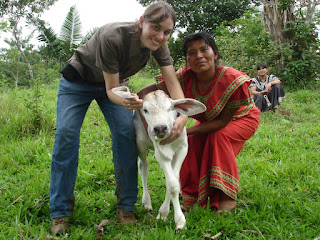 |
| My town- my host family house is on the right |
 |
| Baby blanket, stitched by Florentina, my host mom |
My parents are a constant support for me, even offering to send me socks from the US as a Christmas present. (Thanks, but no thanks). Sometimes I take their support for granted, but I am really blessed to have them. As well as all the extended family and friends that pray for me and read this blog.
Ken is the guy at home. We've been dating for nearly a year now, and long distance since August. Had I entered the Peace Corps in February 2011 as I was expecting to, we wouldn't be having long cell phone conversations. I'm grateful to be living in this age of cell phone and internet communication because otherwise, this connection would probably be impossible. While life as a Harvard grad student is very different from life in the campo, we try to share our experiences and pray through the events of the week. Distance has slowed down and changed the way we interact, but we've been growing in friendship.


My community is all about connections. My weekly trips to town have been my alone time- because in my community of Alto Nube my days are one continuous social interaction. That's a big change from my life in the states, which was often solitary and punctuated by social engagements.
We are starting to construct a house for me to live in & rent for the next 2 years, and to be used by any Volunteers that may come after me as well. A large team of people- men, women, and children- have been working to transform trees and living materials into a house. On our first work day we had 28 people, and we've had 3 work days so far. Our first task was to cut 20 large stalks of bamboo, each of which was cut into 2 sections of about 15 feet long for carrying. We carried them somewhere between half a mile and a mile, on a muddy footpath on our shoulders. The 10 year old boys, accustomed to carrying water and firewood, surpassed me in strength! The next day the team went in search of posts and beams for the house: sturdy trunks of laurel and palm trees. Also, we harvested "penca", palm thatch. Meanwhile another team split the bamboo into strips to use as siding. The posts were buried in the ground, to form corners, windows, and a door. My house will be a 14 by 14 foot square, half of which (7 by 14 ft) will be enclosed in bamboo with a corrugated metal roof, and the other half an open air porch roofed with palm thatch. Labor and most of the materials for the house are being donated by the community, as well as a significant amount of food and firewood for our work parties. I just show up to work and provide most of the food. The work is their gift of cooperation and of friendship. Another gift that I must receive with gratitude.
In my community itself, they're not throwing much of a Christmas party- there's not the resources this year to have a celebration as they sometimes do. After talking with Ken about a subdued Christmas eating rice and beans ("ka ulire," sad times), I realized I'm in a position to invite people to celebrate. It'll be small scale- a homemade piñata and hopefully some games. On Christmas day I'll be going to church.
 |
| Piñata construction |

About a month ago I mentioned a little girl, Melissa, who was severely sick with pneumonia. She recently returned after over a month in the hospital and looks great. In times of need the whole extended family chips in to provide. Here she is (in the blue dress) with her mom and cousin. Something to be thankful for, indeed.













































